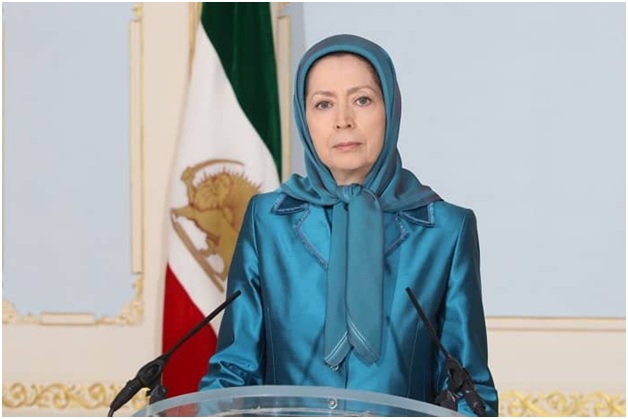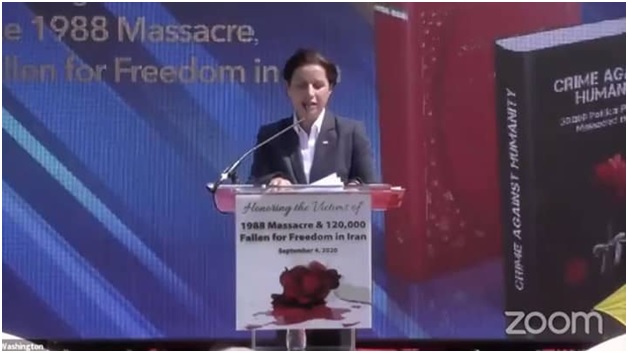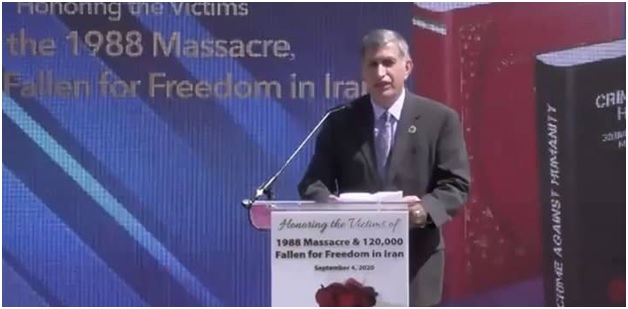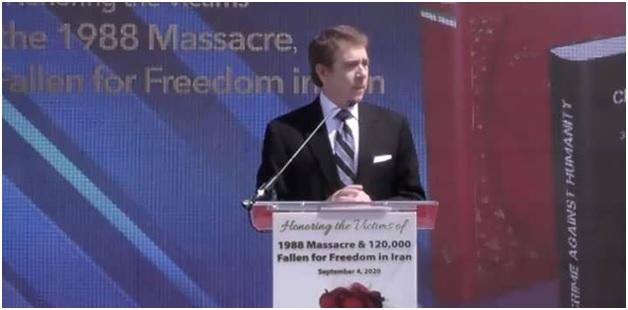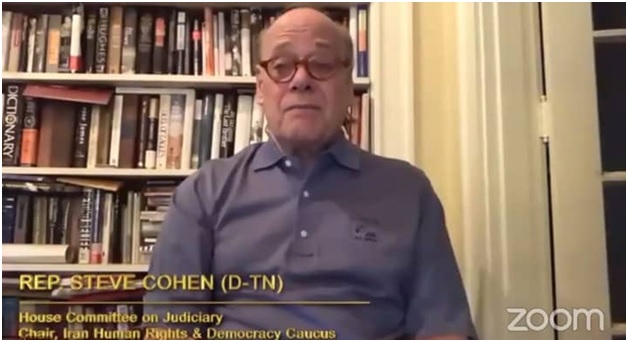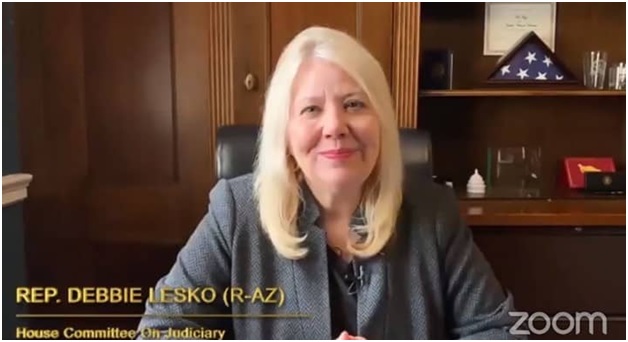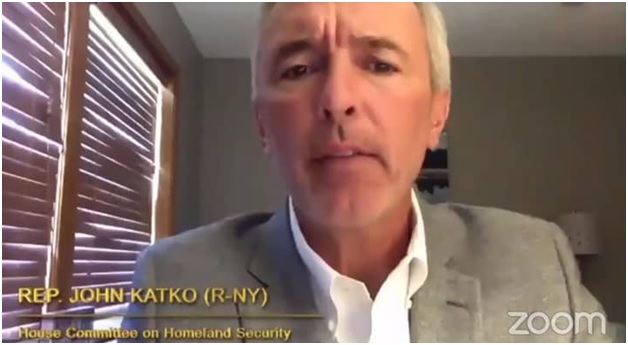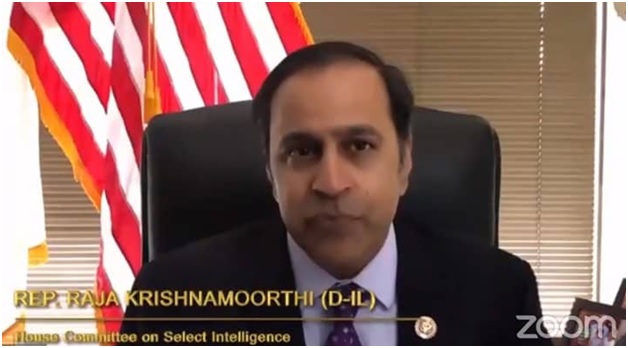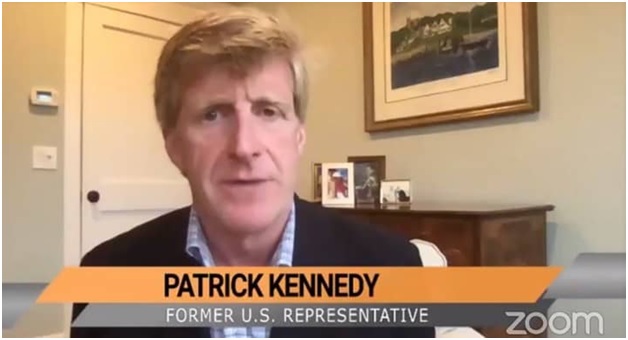Iran’s Terrorism & Human Rights Violations
Photo Exhibit & Rally, Capitol Hill.
Decades of Rights Violation in Iran,
Call for Accountability
Displaying thousands of pictures and posters memorializing over 120,000 men, women and children murdered by the regime for their political beliefs in Iran, Organization of Iranian American Communities (OIAC) held a large photo exhibition on the lawn of the U.S. Capitol, Friday September 4, 2020, urging accountability for the 1988 massacre of 30,000 political prisoners, the November 2019 murder of 1,500 protesters, and the assassination of political dissidents abroad.
Bipartisan members of Congress, personalities, and family members of the victims of the atrocities addressed the event.
Congressman Steve Cohn (D-TN) who chairs the House Iran Human Rights and Democracy Caucus said, “it’s more important than ever that we remember the victims of 1988 and we recommit ourselves to remembering it is important to have a free and independent Iran.”
In his remarks, Congressman John Katko (R-NY) reminded the international community that, “The Iranian regime has continued its campaign of terror at home and abroad, working to silence its critics and those advocating for democratic reform,” including in protests at the end of 2019.

Congressman Raja Krishnamoorthi (D-IL), a member of the House Select Committee on Intelligence echoed numerous Congressional resolutions about the Iranian regime’s rights violations, “including the four-month period in 1988 in which the government of the Islamic Republic of Iran carried out mass executions of thousands of political prisoners from a range of unrelated political groups.” This slaughter he said, “was carried out under the orders of then Supreme Leader Ayatollah Khomeini through kangaroo courts, which executed prisoners and dissidents for as little as refusing to renounce their affiliations with groups perceived as enemies of the regime.”

“I am proud to have co-sponsored, H.Res.374, which condemns the Iranian regime and calls for a democratic, nonnuclear Iran that doesn’t go after its own citizens,” said Congresswoman Debbie Lesko (R-AZ) in her remarks as she pledged to stand with the Iranian American Community in support of the Iranian people.

Congresswoman Angie Craig (D-MN) said the Iranian people and Americans both stand for freedom, democracy, gender equality, free and fair elections and a market economy. She reiterated the event’s call, “to condemn the 1988 massacre in which thousands of political prisoners were killed,” and demanded, “justice for those victims.”

Mrs. Maryam Rajavi, the president-elect of the National Council of Resistance of Iran, who remotely addressed the event said, “In the past 32 years, the Iranian Resistance has persistently called for the masterminds and perpetrators of this great crime against humanity to be held accountable.
“Unfortunately, due to the Western policy of appeasing the ruling religious tyranny, those who ordered and perpetrated this crime, namely the regime’s most senior leaders, have so far evaded facing justice.”
Mrs. Rajavi added, “The experience of the past 40 years has shown that no amount of political and economic concessions will change the behavior of the mullahs’ regime.”
“The international community must, therefore, adopt a firm policy and apply maximum pressure on the regime, including referring its human rights record to the UN Security Council. It must also implement the six UN Security Council resolutions and stand with the people of Iran and their organized Resistance,” She concluded.
Former Congressman Patrick Kennedy recalled the massacre of 1988, murder of MEK members in Camp Ashraf in Iraq, and assassination of Iranian dissidents in Europe, all ordered or carried out by Iranian regime officials now working at highest levels of the Iranian regime. “When the regime operates with impunity for nearly four decades, the outcome is more killings and a continuity of torture and imprisonment because they’ve never been held accountable,” Mr. Kennedy noted. That is why, he said, “on this anniversary we have to be reminded that the United States can and should play a leading role in the United Nations Security Council to call for an investigation about the massacres in 1988 and in 2019.”

In his speech, Former State Department Special Envoy and Assistant Secretary of State for Political Military Affairs, Ambassador Lincoln Bloomfield referred to the 1988 massacre as an annihilation of the MEK prisoners by Khomeini. He went over the history of terrorism mentioning killing of Kazem Rajavi in Geneva, Kurdish leaders in Berlin, blowing up Jewish Community Center in Argentina, and other similar activities. He described the policy of the regime as executions inside and terrorism outside. Ambassador Bloomfield said, “A reign of terror started inside the country, Khamenei extended it outside the country; executions inside the country, terrorism, hit teams and intelligence propaganda trying to cover it all up”. He concluded his speech by brining attention to ongoing violations of human rights in Iran: “They have sentenced Iranian wrestler Navid Afkari to death and his brothers to decades in prison for standing in protest. These are brave people, ladies, and gentlemen. Let’s stand with them.”

Ambassador Kenneth Blackwell, the former U.S. envoy to the UN Human Rights Commission called upon everyone to be on the side of those advancing universal human rights. “In 1988, 30,000 political prisoners were victims of summary executions by the regime of Iran. We must be that alarm clock for justice. We must be protectors of human dignity everywhere. We can’t be on the ground in Iran. But we can do what we can where we are. Our world depends on it. Those who were the victims of that gross injustice against humanity are witnesses, watching how we run the race that is marked for us in our time. Let’s continue to speak up; let’s continue to demand that justice is done,” said Ambassador Blackwell.
Mr. Bruce McColm, former Executive Director of the Freedom House dedicated his speech to Dr. Kazem Rajavi and his human rights activities. He said that “[Kazem Rajavi] belongs in the human rights Hall of Fame.” He went on to say that “many of the resolutions that guide the Human Rights Commission today in terms of Iran” were introduced by Kazem Rajavi. Mr. McColm was delighted to see the State Department has listed the names of Rajavi’s assassins and added, “It would be wonderful to see these people brought to justice.”
Mr. Glenn Allen Torshizi, a DC-area telecom engineer, whose three brothers were executed by the Iranian regime addressed the event. Mr. Torshizi, the only surviving son in the family, said that his family’s only offense was to stand for freedom and political affiliation with the main Iranian opposition, the MEK.
The daylong event concluded at dusk with the lighting of thousands of photos of those fallen for freedom and democracy at home and abroad.
‘Crimes against humanity’: Group holds event near Capitol Hill featuring photos of thousands killed in Iran
by Zachary Halaschak, Breaking News Reporter | September 04, 2020 05:57 PM
https://www.washingtonexaminer.com/news/crimes-against-humanity-group-holds-event-near-capitol-hill-featuring-photos-of-thousands-killed-in-iran
The faces of thousands of people killed by the Iranian regime were featured in a photo exhibit outside of Capitol Hill on Friday.
“Today’s exhibit of pictures of 120,000 fallen for freedom in Iran manifests the Iranian people’s resolve for freedom while urging the international community to apply maximum pressure on the regime, including referring its human rights record to the U.N. Security Council,” Ramesh Sepehrrad, an advisory board member for the Organization of Iranian American Communities, told the Washington Examiner.
The OIAC, which put on the event, is based in the United States and is tied to the National Council of Resistance of Iran, a leading dissident organization working to overthrow the Iranian regime.
Displays show the photos of thousands of people killed by Iran over the past decades. The photos were set up outside of Capitol Hill on Friday.
(OIAC)
The regime’s killing of political prisoners in the 1980s, particularly in 1988, was a major focus. That year, thousands of activists who spoke out against the regime were secretly and summarily executed without trials. Among the faces were some of the estimated. Among the faces were some of the estimated 1,500 who were killed during the mass protests against the regime in November 2019.
The event featured a bipartisan slate of speakers, including Republican Reps. John Katko of New York and Debbie Lesko of Arizona and Democratic Reps. Steve Cohen of Tennessee, Angie Craig of Minnesota, and Raja Krishnamoorthi of Illinois.
Maryam Rajavi, the leader of the National Council of Resistance of Iran, also spoke at the event. She said the thousands of photos “depicts only a small part of the crimes and terrorism committed by the ruling religious fascist regime.”
She added, “I have continually called on the international community to condemn the clerical regime and to take urgent action to stop the executions.”
NCRI leader Maryam Rajavi remotely addresses the Friday event.
(OIAC)
One of the speakers, Lincoln Bloomfield, touched on Navid Afkari, an Iranian champion wrestler who was given two death sentences for his participation in protests against inflation in 2018. President Trump drew attention to Afkari on Thursday when he asked the leaders of Iran to spare the 27-year-old’s life over Twitter. Bloomfield said the world needed to stand by those like Afkari.
“They have sentenced Iranian wrestler Navid Afkari to death and his brothers to decades in prison for standing in protests. These are brave people, ladies and gentlemen. Let’s stand with them,” Bloomfield told those watching the event. Most were doing so virtually.
Bloomfield, who served as a national security official in the administrations of former Presidents Ronald Reagan, George H. W. Bush, and George W. Bush, told the Washington Examiner in an interview after his speech that the killings carried out by Iran in 1988 should be better publicized and more well-known than they are.
“This is one of the worst crimes against humanity since World War II,” Bloomfield said. He noted that while the world was largely left in the dark during the worst of the 1980s killings, “there’s a lot of evidence in 2020 that didn’t exist” at the time of the executions.
Bloomfield said that many of the judges who gave the orders to kill various dissidents in 1988 are now the people leading the country and its judiciary, and he compared the atrocious nature of the executions to the Bataan Death March.
“The guilty are sitting there exercising power,” Bloomfield said. He said the international community should be working together to document the past actions of the Iranian regime.
Bloomfield added that while various governments disagree about the nuances of the Iran nuclear deal, arms embargoes, and other international treaties, “one thing they’ve never disagreed on is what to do about major crimes against humanity. Whether it’s Hitler or Pol Pot or the former Yugoslav leaders, they have gone to justice, and that’s what needs to happen now.”
The event comes the same week as human rights group Amnesty International released an 80-page report detailing Iran’s torture and killing of its own citizens during the November 2019 protests. Earlier this summer, the U.S. State Department branded Iran as the “foremost state sponsor of terrorism” in its annual Country Reports on Terrorism.
 Group holds event near Capitol Hill featuring photos of thousands killed in Iran – Reports
Group holds event near Capitol Hill featuring photos of thousands killed in Iran – Reports
https://www.thebritishjournal.com/world/group-holds-event-near-capitol-hill-featuring-photos-of-thousands-killed-in-iran-reports-74629-2020/
The faces of thousands of people killed by the Iranian regime were featured in a photo exhibit outside of Capitol Hill on Friday.
“Today’s exhibit of pictures of 120,000 fallen for freedom in Iran manifests the Iranian people’s resolve for freedom while urging the international community to apply maximum pressure on the regime, including referring its human rights record to the U.N. Security Council,” Ramesh Sepehrrad, an advisory board member for the Organization of Iranian American Communities, told the Washington Examiner.
The OIAC, which put on the event, is based in the United States and is tied to the National Council of Resistance of Iran, a leading dissident organization working to overthrow the Iranian regime.
The regime’s killing of political prisoners in the 1980s, particularly in 1988, was a major focus. That year, thousands of activists who spoke out against the regime were secretly and summarily executed without trials. Among the faces were some of the estimated 1,500 who were killed during the mass protests against the regime in November 2019.
The event featured a bipartisan slate of speakers, including Republican Reps. John Katko of New York and Debbie Lesko of Arizona and Democratic Reps. Steve Cohen of Tennessee, Angie Craig of Minnesota, and Raja Krishnamoorthi of Illinois.
Maryam Rajavi, the leader of the National Council of Resistance of Iran, also spoke at the event. She said the thousands of photos “depicts only a small part of the crimes and terrorism committed by the ruling religious fascist regime.”
She added, “I have continually called on the international community to condemn the clerical regime and to take urgent action to stop the executions.”
One of the speakers, Lincoln Bloomfield, touched on Navid Afkari, an Iranian champion wrestler who was given two death sentences for his participation in protests against inflation in 2018. President Trump drew attention to Afkari on Thursday when he asked the leaders of Iran to spare the 27-year-old’s life over Twitter. Bloomfield said the world needed to stand by those like Afkari.
“They have sentenced Iranian wrestler Navid Afkari to death and his brothers to decades in prison for standing in protests. These are brave people, ladies and gentlemen. Let’s stand with them,” Bloomfield told those watching the event. Most were doing so virtually.
Bloomfield, who served as a national security official in the administrations of former Presidents Ronald Reagan, George H. W. Bush, and George W. Bush, told the Washington Examiner in an interview after his speech that the killings carried out by Iran in 1988 should be better publicized and more well-known than they are.
“This is one of the worst crimes against humanity since World War II,” Bloomfield said. He noted that while the world was largely left in the dark during the worst of the 1980s killings, “there’s a lot of evidence in 2020 that didn’t exist” at the time of the executions.
Bloomfield said that many of the judges who gave the orders to kill various dissidents in 1988 are now the people leading the country and its judiciary, and he compared the atrocious nature of the executions to the Bataan Death March.
“The guilty are sitting there exercising power,” Bloomfield said. He said the international community should be working together to document the past actions of the Iranian regime.
Bloomfield added that while various governments disagree about the nuances of the Iran nuclear deal, arms embargoes, and other international treaties, “one thing they’ve never disagreed on is what to do about major crimes against humanity. Whether it’s Hitler or Pol Pot or the former Yugoslav leaders, they have gone to justice, and that’s what needs to happen now.”
The event comes the same week as human rights group Amnesty International released an 80-page report detailing Iran’s torture and killing of its own citizens during the November 2019 protests. Earlier this summer, the U.S. State Department branded Iran as the “foremost state sponsor of terrorism” in its annual Country Reports on Terrorism.
The post ‘Crimes against humanity’: Group holds event near Capitol Hill featuring photos of thousands killed in Iran appeared first on Washington Examiner.

Iranian Opposition Supporters in US Held a Photo Exhibition and Rally, Condemn Regime’s Human Rights Violation and Terrorism
By INU– September 4, 2020
Since the beginning of the reign of Iran’s regime, it has been accused by the international community for financing, providing weapons, and be the safe haven for global terror groups like the Hezbollah, Al-Qaeda, and many others. The IRGC as the main actor of this first state-terror sponsor, promoting the regime’s spread of ideology in neighboring regions by training and funding terrorist organizations. Another aspect of the regime’s terror policy is its domestic repression and massacres like the events of 1988, in which the regime executed more than 30,000 political prisoners in a short time, in the hope of wiping out any confrontation with it.
OIAC, the organization of Iranian American communities on September 4 holds a photo exhibition and rally on the U.S. capital Hill Grounds to remember this event and call the international community to bring justice and to verdict the regime.
On Capitol Hill Ground, thousands of photos and graphics represent the crime of this regime and its victims over the past 41 years. Remarks were also provided by survivors of these atrocities, as well as members of the U.S. Congress and political dignitaries.
The event also called on the international community to take immediate action to save Navid Afkari, an Iranian wrestler who has been sentenced to death for taking part in November 2019 protests.
Maryam Rajavi, President-elect of the National Council of Resistance of Iran (NCRI)
By a video message Mrs. Maryam Rajavi the President-elect of the NCRI, on this event said:
“Holding this exhibition is particularly inspiring and effective on the 32nd anniversary of the massacre of 30,000 political prisoners in Iran in 1988,” said Maryam Rajavi, President-elect of the National Council of Resistance of Iran (NCRI). “Nonetheless, it depicts only a small part of the crimes and terrorism committed by the ruling religious fascist regime. One of the most horrific cases committed by the clerical regime was the massacre of political prisoners in 1988,” Madam Rajavi added.
“In the past 32 years, the Iranian Resistance has persistently called for the masterminds and perpetrators of this great crime against humanity to be held accountable,” Madam Rajavi continued, reminding that due to the Western policy of appeasing the ruling religious tyranny, those who ordered and perpetrated this crime, namely the regime’s most senior leaders, have so far evaded facing justice. Some of these figures include Ebrahim Raisi, the regime’s judiciary chief, and Alireza Avayi, the current Justice Minister, who were members of the death commissions during the 1988 massacre.
“And now, more than three decades later, the blood of the victims of the 1988 massacre is roaring across Iran and inspiring young people,” she continued.
Madam Rajavi reiterated that the regime’s crimes continue to this day. “The savage execution of Mostafa Salehi and the Judiciary’s ruthless decrees for the execution of detained protesters, indicate the desperation of a regime on its last legs. The criminal verdicts for Navid Afkari, a young wrestler, and his two brothers, and for other prisoners who are among the country’s most enlightened youths attest to the regime’s panic and fragility.
“I have continually called on the international community to condemn the clerical regime and to take urgent action to stop the executions. I urge you to persistently follow up on this to prevent these inhuman verdicts from being carried out against Iran’s young generation.”
Madam Rajavi also reminded the audience that in tandem with its human rights abuses, the regime has resorted to terrorism and demonization against the opposition. “Over the past 40 years, in addition to suppression, the mullahs have been targeting the PMOI/MEK and the Iranian Resistance every day with their slanders and lies in an extensive and expensive demonization campaign. The flip side of the demonization campaign is the mullahs’ unbridled terrorism, the sharp edge of which is directed against Iranian dissidents, specifically the PMOI/MEK and the Iranian Resistance,” she said.
Madam Rajavi stressed that the key to stopping the Iranian regime’s crimes is to hold it to account for its terrorism and human rights abuses. “The time has come for the closure of the Iranian regime’s embassies which serve as centers for terrorist operations. The clerical regime’s leaders must also be held accountable and punished for their crimes.
“The experience of the past 40 years has shown that no amount of political and economic concessions will change the behavior of the mullahs’ regime.
“The international community must, therefore, adopt a firm policy and apply maximum pressure on the regime, including referring its human rights record to the UN Security Council. It must also implement the six UN Security Council resolutions and stand with the people of Iran and their organized Resistance.”
Rahileh Sadeghpour, sister of a 1988 massacre victim
I’m the sister of Hamid Sadeghpour, my brother. He was one of the smartest students in his high school. He was a supporter of the MEK. He was very active with the movement. In July 1981, he was arrested for supporting the MEK. He spent seven years in prison.
The regime severely tortured my brother. They drove nails into his feet. But he always had his smile when we went to meet him. That is the person he was.
One day, after waiting a long time to meet him, my mother was told Hamid was not in prison. Finally, after an extensive search, they learned that he was transferred to Evin and after that to Gohardasht prison.
After he endured seven years in prison and torture chambers, he was killed by the regime.
Another story is that of Ameneh Afzali, my dear friend. At the time of her execution, she was 17 years old. In the summer of 1981, she was severely tortured in prison because of her affiliation with MEK. But she did not give in. They shot her and threw her bullet-ridden body into a ditch, where she bled to death.
We would be chased in the streets by the Revolutionary Guards (IRGC). We were beaten with the stocks of machine guns. They took us to IRGC headquarters. We were taken to a large, darkroom. The room was so crowded that we all had to stand. My friend Maryam was sentenced to 70 lashes. I could hear her screams.
Four decades later, those sacrifices have inspired a new generation. We saw that in the protests of November 2019. The movement for freedom in Iran is growing. It has spread across Iran and includes all sectors of the society.
The stories of torture, execution, beheading, the severing of limbs, these stories are endless. But that is not where this story ends. The awe-inspiring resistance to say no to the mullahs, to never give in, that writes the rest of the history of Iran and Iranians.
Gholam Torshizi, brother to three 1988 massacre victims
I am the only survivor of four brothers. Three of my brothers have been executed by the regime. The regime must be held to account.
My younger brother Behrooz was very gifted and talented. He was a supporter of the MEK when he was studying in college. In 1981, one day he left home, and we never saw him again. We searched for him for 17 days. Finally, we found out about his fate in the newspaper Keyhan among the names of others executed. The news was a shock to our family.
My father reached out to the inspector general’s office. The cleric told my father, ‘your son had a camera and was taking pictures of a MEK demonstration.’
These criminals are still in charge, the same people who killed my brother. They sentenced him to death without access to a lawyer. They tortured him for 17 days, killed him, and buried him in the Behesht-e Zahra Cemetery without telling my family.
My other brother, Bahman, was also a supporter of the MEK. He disappeared in January 1982. We never found him.
My third brother Reza was a swimming champion and a member of the MEK. After Bahman’s disappearance, Reza went into hiding with my mother. They both disappeared. My father started searching for my mother and two brothers.
My mother came back after a month and told us that Bahman was killed by the IRGC. My other brother was arrested with my mother and taken to Evin prison. We later learned that Reza was sentenced to seven years in prison and later taken to Ghezel Hesar prison of Karaj, located west of the Iranian capital Tehran.
In 1988 Reza’s seven-year sentence was over. My father reached out to the inspector general’s office to ask why Reza was not released. They said he had not repented. Reza later told my father that those who repent are asked to kill those who have not repented. ‘I cannot do that,’ he said.
One day, my father was summoned to the prison. He thought his son was released. But instead, they informed him that Reza was executed, and they gave him a bag with his belongings.
I am proud of my brothers and all the martyrs who have sacrificed their lives for freedom. They are the true face of Iran, the face of the resistance.
Today I’m asking the world community to stop talking with the mullahs. Their hands are soaked with the blood of innocents. The time has come for criminals like Khamenei to be arrested for their crimes.
Stand beside the Iranian people’s resistance movement.
Amb. Lincoln Bloomfield, former U.S. Assistant Secretary of State for Political-Military Affairs
Why are we talking about an event that took place 32 years ago? The massacre of the political prisoners of Iran in 1988 was one of the worst crimes in the post-World War II era. The regime lied to the world. But the truth has come out.
We know that the people who sent these political prisoners to their death are still in power today. We have the proof and we have those who are culpable.
This was a pivotal moment in Iran’s history. We must know who were these people who were killed? In America, we have heard about MEK for many years. We were told they are terrorists, Marxists, a cult, whatever. But this is what the regime told us.
After the revolution, MEK activists held rallies and called for political and social rights. This was unacceptable for the Khomeini regime. On June 20, 1981, Khomeini began a reign of terror. Even boys and girls were arrested for political activities. They were sent to jail, tortured, and murdered.
In 1988, Khomeini ordered the annihilation of the MEK prisoners. Many had completed their sentences. The prisoners were asked whether they were still loyal to their views. They were proud people and said they still believed in their views. They were killed by the dozens, they were hung, machine-gunned, wrapped up, and buried in mass graves where they could not be found. Their possessions were delivered to the homes of their families and the families were told their loved ones were killed.
After Khamenei became a supreme leader, he resorted to assassinations and terrorism abroad. For thirty years, Iran has been the number one state-sponsor of terrorism.
We are here to make sure the prisoners are remembered. We cannot ignore 1988 anymore. This was one of the largest crimes against humanity. The United States and some of its allies do not always agree on policies toward Iran. But they don’t disagree on Iran’s human rights violations.
The people who sent these political prisoners to their deaths must be held to account. I call upon my government and other governments to act now.
They must stop these extrajudicial killings. They have sentenced Iranian wrestler Navid Afkari to death and his brothers to decades in prison for standing in protests. These are brave people, ladies, and gentlemen. Let us stand with them.
Rep. Steve Cohen (D-Tennessee)
What went on in 1988 must be remembered. What is going on in Iran is still horrific. The actions of the government have been repression against people’s rights. It is more important than ever to remember the victims of the 1988 massacre. We must have a free Iran.
Rep. Angie Craig (D-Minnesota)
I join you to condemn the 1988 massacre. I join the thousands who raise their voices to call justice for the victims. We both have a history of disavowing the terrorism of the regime against the people of Iran. I will continue to support you.
Rep. Debbie Lesko (R-Arizona)
My thoughts and prayers are with those who knew people or had relatives killed in the 1988 massacre. I am a co-sponsor of the House resolution that condemns the regime and calls for a non-nuclear Iran. I appreciate what you are doing and stand with you to support your mission.
Rep. John Katko (R-New York)
The Iranian regime has continued its campaign of terror at home and abroad. They regularly target Iranians who call out their rights abuses. The Iranian regime is the biggest state-sponsor of terrorism.
It spends 1 billion dollars to fund proxies to spread terrorism. Last year they killed more than a thousand protesters who raised their voices. We stand with you.
Rep. Raja Krishnamoorthi (D-Illinois)
Together, we need to support the ongoing fight for human rights in Iran and speak the truth of the past, including the mass executions of thousands of political prisoners in 1988. This slaughter was carried out under the order of Khomeini. I am proud to join you in speaking out against these human rights violations and any attempt to deny the truth.
Patrick Kennedy, a former member of the U.S. House of Representatives
It’s important that we remember who we are dealing with, the mullahs in Iran, and we recognize that things really have not changed. The massacres have continued. We saw it last year in the uprisings, and all those young people killed in Iran’s streets.
We continue to see this in attacks and assassination attempts abroad. We have come to expect this from the fascist dictator to Iran. This is a sad state of affairs that the world has become accustomed to Iran’s violent behavior.
The mullahs promised a revolution and instead delivered a dictatorship that has terrorized people. MEK members have been on the front lines. They have been the chief target of the Iranian regime. There is no question as to why the regime continues to target MEK members. They know the MEK is organized, that they stand for a platform, that Maryam Rajavi’s ten-point planchallenges who the mullahs are.
We remember those MEK members who laid down their lives, the scores of members who were attacked and killed in Camp Ashraf and Camp Liberty.
There has been no doubt that the Iranian government pursues the MEK wherever they go because they have a tremendous message. Once Iranians get to see how many of their countrymen are frustrated about how their country is being run, it is no surprise that the people of Iran are protesting.
The mullahs have no respect and they continue to torture and imprison and execute. They are the number one country in the world for the percentage of people they execute. Any government that does that to their own people has no legitimacy whatsoever.
Kenneth Blackwell, former U.S. Ambassador to the United Nations Human Rights Commission
In 1988, 30,000 political prisoners were victims of summary executions by the regime of Iran. We must be that alarm clock for justice. We must be protectors of human dignity everywhere. We can’t be on the ground in Iran. But we can do what we can where we are.
Our world depends on it. Those who were the victims of that gross injustice against humanity are witnesses of how we run the race in our time. Let’s continue to speak up and demand justice is done.

I knew Kazem Rajavi. He belongs in the human rights Hall of Fame. He was assassinated thirty years ago by Ayatollah Khamenei. He was the first representative of Revolutionary Iran in the UN. He resigned because of arbitrary arrests and execution in his country. He was very active in defending human rights in Iran.
They killed him in his driveway in his home in Geneva. We had a memorial for Kazem at the UN headquarters in New York.
We have to remember Kazem spent his career in human rights. He was an extraordinary man, very humble, very accessible. He had six PhDs, an incredible person. We remember him and all those fallen for freedom.
Many of the same people who were the culprits in these incidents are still around, they’re still alive and still, have blood on their hands. Kazem was a great aristocrat of freedom, someone who was born with the urge to have his people free.



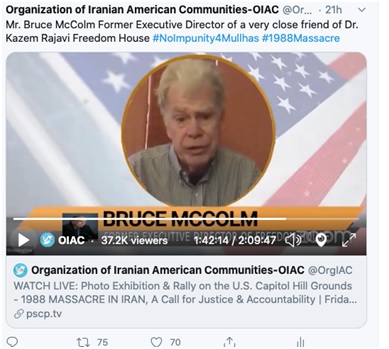
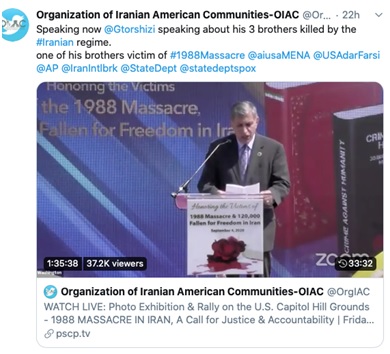

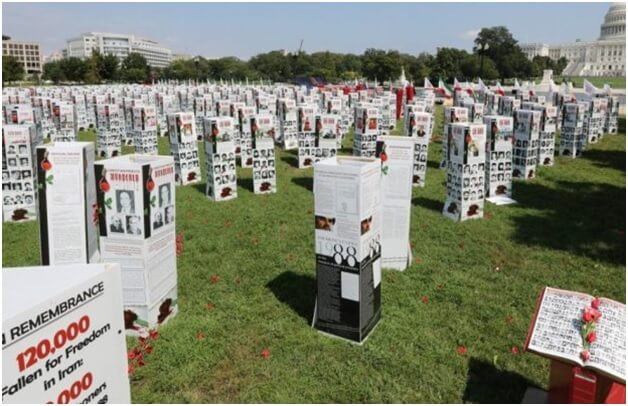
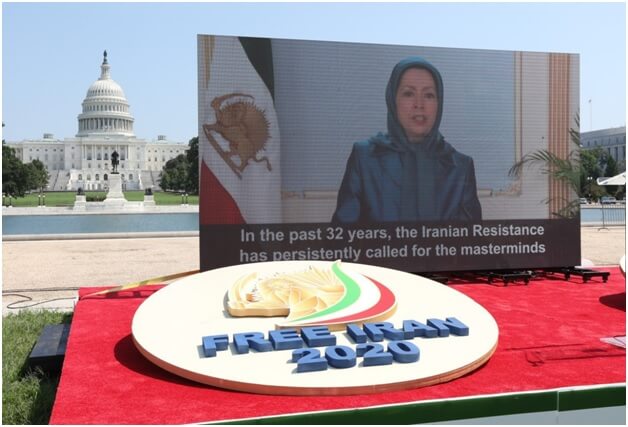
 http://www.apimages.com/Search?query=siavosh+hosseini&ss=10&st=kw&entitysearch=&toItem=52&orderBy=Newest&searchMediaType=excludecollections
http://www.apimages.com/Search?query=siavosh+hosseini&ss=10&st=kw&entitysearch=&toItem=52&orderBy=Newest&searchMediaType=excludecollections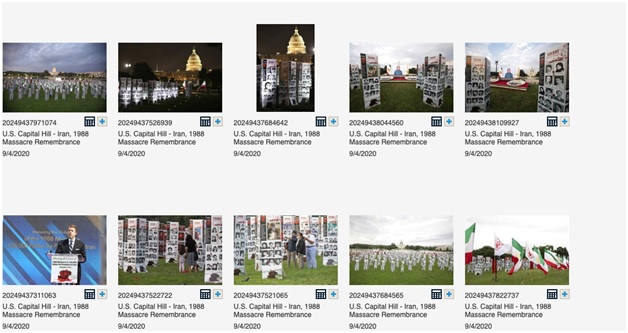
 Group holds event near Capitol Hill featuring photos of thousands killed in Iran – Reports
Group holds event near Capitol Hill featuring photos of thousands killed in Iran – Reports